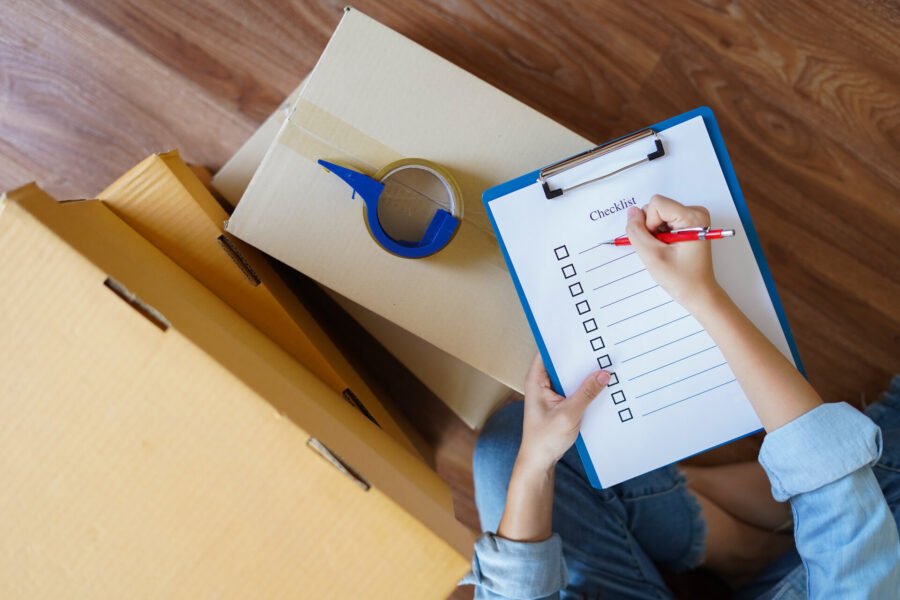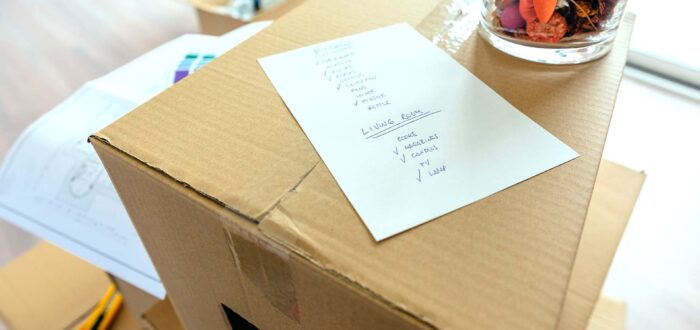

Beyond the Basics: Elevating Your Packing List Game
Posted in Moving Tips & Tricks,Planning the Move on May 19, 2023
When it comes to travel, being well-organized can make all the difference, especially when it comes to what you want to bring with you. Making a packing list is the best way to stay organized during a move. While many people may focus on the basics, such as clothing, toiletries, and electronics, several other items can take your relocation game to the next level. So, here is a complete guide to help you out.
Packing Lists Basics: A Quick Refresher
Long distance moving can be stressful and complicated, especially when it comes to shipping all of your belongings. Whether you’re moving across country or just a few blocks away to a different neighborhood, having a well-planned list can make the relocation process smoother and less stressful.
However, it’s easy to overlook important items or forget to pack certain things when you’re caught up in the chaos of moving. So, here’s a quick refresher on basics, including essential items to include, tips for organizing your lists, and how to ensure that you don’t forget anything important. By following these guidelines, you’ll be well on your way to a successful and stress-free move.
The Importance of Making a Checklist
One of the most crucial aspects of successful relocating is creating a checklist. Not only does this help ensure that you don’t forget any important items, but it also helps you stay organized and avoid overpacking.
Creating a checklist also allows you to prioritize items based on their importance, and it can be a helpful reference. You can use it to make sure you don’t leave anything behind when checking out of your hotel or filling the trunk of your rental car. It can also be useful when repacking your luggage to head back home, ensuring you don’t accidentally leave anything behind.

Basic Items to Include in a Packing List
When it comes to creating a checklist to help you pack efficiently, there are several basic items that you should include to ensure a successful relocation. These items include packing materials such as boxes, tape, and bubble wrap, as well as labeling materials such as markers and labels.
You’ll also want to include essential household items such as toiletries, bedding, and clothing, as well as any important documents or valuables. By including these basic items, you’ll be well-prepared and able to minimize stress and potential relocation mistakes.
Tips for Organizing the List
Organizing your packing can help you stay on track and ensure you don’t forget anything important, and it’s key to a stress-free relocation. One approach is to divide your lists into categories such as clothing, toiletries, electronics, and miscellaneous items. This can help you see at a glance what items you still need to add and pack, and it can also make the process of unpacking easier.
It’s also helpful to prioritize items based on their importance. For example, if you’re traveling to a remote location, it may be more important to pack a first aid kit and emergency supplies than it is to pack multiple outfits for every occasion.
Consider using an app or a printable to help you stay organized. These tools often include pre-made checklists based on the length of the trip and destination, making it easier to ensure you don’t forget anything important.
Once you’ve created your list, review it carefully to ensure that you haven’t missed anything important. Make changes as necessary and keep it with you during the relocation to ensure that everything arrives at your new home safely. If you need some extra advice on how to make these kinds of lists, watch this video.
Elevate Your Guide to Packing for a Move
Relocating can be an overwhelming process, but with the right approach, it can also be an opportunity to declutter, organize, and start fresh. When it comes to preparing for a relocation, there are several ways you can elevate your approach to make the process smoother and more efficient.
Include a Timeline
One way to elevate your approach is to create a timeline for the process. This can help you stay organized and ensure that you don’t leave everything until the last minute. Start by setting a relocation date and working backward from there, creating a schedule.
For example, the smartest thing to pack first are items that you won’t need in the immediate future, like seasonal clothing or decor. Then, pack items in rooms that you use less frequently, such as the guest room or basement. Finally, pack the items that you use on a daily basis, for example, kitchen supplies and toiletries.
Create a Theme
Another way to elevate your approach is to create a theme for your relocation. This can help you stay focused and make decisions about what to keep and what to get rid of. For example, you may choose a minimalist theme and aim to only keep the items that you truly need and love.
Or, you may choose a sustainability theme and aim to minimize waste and use eco-friendly materials. Having a theme can also make the process more enjoyable and meaningful. You may want to create a vision board or playlist to keep you motivated.
Utilize Technology
Technology can also be a helpful tool when it comes to preparing for a move. Consider using an app to keep track of your inventory, create labels for boxes, and keep track of which items are in which box. You may also want to utilize technology to help you declutter before your move. There are several apps and websites available that can help you sell or donate unwanted items, such as Craigslist.

Making a Packing List for Moving Cross Country
Moving cross country can be an exciting adventure, but it also requires careful planning and organization to ensure that everything goes smoothly. One of the most important aspects of a successful cross-country move is having a well-planned checklist. Here are some tips to help you out.
- Consider the length and purpose of your relocation. If you plan to stay in temporary housing for some time, you’ll need to prepare differently than if you’ll be moving into your new home immediately. You’ll also want to consider the climate and time of year, as this will impact the types of clothing and gear you’ll need.
- Think about the specific items you’ll need for your new home. This includes furniture, bedding, kitchen supplies, and any other household items that you’ll need for day-to-day living. Make a list of these items and prioritize them based on their importance.
- Consider any special items that require extra care during the relocation, such as valuable or fragile items. Make sure to label these items clearly and ship them separately to ensure that they arrive at your destination in good condition.
- Consider any items that you can sell or donate before your relocation. Cross-country relocation can be expensive, and minimizing your belongings can help save money. Think about having a garage sale or using online marketplaces to sell items you no longer need.
Special Considerations for Packing When Moving
When moving cross-country, there are several special considerations to keep in mind when trying to pack. Here are some tips to help ensure that your items arrive at your destination safely and in good condition.
- Make sure to use high-quality protection materials. This includes sturdy boxes, tape, bubble wrap, and foam peanuts. You may also want to consider using plastic bins with lids for items that are more fragile or valuable.
- When wrapping fragile items, use plenty of protective material to ensure that they are well-protected. Wrap each item individually in bubble wrap or protection paper and pack them tightly in the box to prevent movement during transport.
- Label your boxes clearly with the contents and destination room to make unpacking easier. Consider color-coding your boxes by room to make it easier for long distance movers to unload them at your destination.
- If you’re relocating in winter, be sure to take extra precautions with items that are sensitive to extreme temperatures. This includes electronics, plants, and any other items that may be damaged by cold temperatures.
- Finally, consider purchasing insurance for your move to protect your items in case of loss or damage during transport.
How to Make a Packing List Specifically for a Move
Making a list for a move can seem overwhelming, but it doesn’t have to be. By following a few key steps, you can create a comprehensive list that will help you stay organized and ensure that everything arrives at your new home safely.
Start by writing down an inventory of all of your belongings. This will help you determine what you need to bring with you and what you can sell, donate, or throw away. Make a list with all the items and prioritize them based on their importance. Next, break down your list into categories, such as kitchen items, clothing, and electronics. This will help you stay organized and ensure that you don’t forget anything important.
Label each box clearly with the contents and destination room. You may also want to color-code your boxes by room to make it easier for movers to unload them at your new home. Finally, make sure to pack strategically to prevent damage to your belongings. Use high-quality protective materials like bubble wrap to wrap fragile items, and place them tightly in the box to prevent movement during transport.
Tips for Packing Efficiently and Safely
When preparing your belongings for a move, there are several tips you can follow to make the process more efficient and safe. Here are a few to keep in mind.
- Start preparing early – give yourself plenty of time to ensure that everything is packed properly. This will also help you avoid last-minute stress and ensure that you don’t forget anything important.
- Use high-quality protection materials.
- Label your boxes clearly with the contents and destination room to make unpacking easier. Consider color-coding your boxes by room to make it easier for movers to unload them at your new home.
- When it comes to heavy items, such as books or appliances, use smaller boxes to avoid overpacking and making the box too heavy. This will also make it easier to lift and transport the box.
- Consider purchasing insurance to protect your items in case of loss or damage during transport.
For Any Packing Doubts, Contact Cross Country Movers to Do It for You
If you’re feeling overwhelmed by the relocation process or simply don’t have the time or resources to do it yourself, consider contacting and hiring a professional relocation company. With years of experience and specialized training, professional movers have the expertise to handle all types of items, from fragile antiques to large furniture pieces. They also have access to high-quality materials and tools to ensure that everything is packed efficiently and safely.
Hiring a professional moving company for their moving services can also save you time and energy. They’ll take care of everything, so you can focus on other aspects of your relocation. When choosing a professional relocation company, look for one that offers a range of services to meet your specific needs. Make sure to ask about their experience and certifications, as well as their pricing and insurance options.
What Cross Country Moving Services Are Available With Professionals?
Professional cross-country movers offer a range of services to meet your specific relocation needs. Here are some of the most common services offered:
- Full or partial packing services – Professionals will use high-quality materials and techniques to ensure that your belongings are packed safely and efficiently.
- Loading and unloading – Professional movers will load and unload your belongings onto the relocation truck, using specialized tools and equipment to ensure that everything is loaded safely and securely.
- Transportation – Professional movers will transport your belongings to your new home using the most efficient and safest route.
- Storage services – If you need to store your belongings before or after your move, professional movers can provide secure storage options to meet your needs.
- Unpacking – Professional movers can provide unpacking services, helping you get settled in your new home more quickly and efficiently.
Ensure You Have a Packaging Checklist Worthy of Your Relocation
In conclusion, having a comprehensive checklist is crucial to ensuring a smooth and successful relocation. If you’re feeling overwhelmed or unsure about handling the entire relocation process on your own, contact us and let Cross Country Movers handle it for you. With their expertise and range of services, they can help ensure that your relocation is as seamless and stress-free as possible.
FAQ
What Are the Essential Items I Should Include in My Packing List?
The essential items you should include will vary depending on your relocation. However, some basic items that you should include are clothing, toiletries, electronics, travel documents, any necessary medications, and a first aid kit.
How Early Should I Start Making My Packing List Before a Trip?
It’s a good idea to start at least a few weeks before your relocation, and even earlier if you can. Starting early gives you plenty of time to think through what you’ll need to bring and make any necessary purchases before your relocation.
Is It Better to Make a Packing List on Paper or Digitally?
Whether you choose to make your list on paper or digitally is a matter of personal preference. Some people prefer the tactile experience of writing it out by hand, while others prefer the convenience and flexibility of digital lists that can be easily edited and accessed from anywhere.
How Can I Make Sure I Don't Forget Anything When Making a Packing List?
To make sure you don’t forget anything, start by making a list of the basic items you’ll need and then build from there. Consider using a pre-made checklist as a starting point and customize it based on your specific needs. Review it several times and consider sharing it with others to get feedback and ensure you haven’t overlooked anything.
What Are Some Common Mistakes People Make When Making a Packing List?
Some common mistakes people make include overpacking, underpacking, not considering the climate, forgetting essential items such as important documents or medications, and not reviewing their list multiple times before the move.
How Detailed Should My Packing List Be?
The level of detail will depend on your personal preferences and needs. Some people prefer to create detailed lists with specific items from each room, while others prefer to keep it simple with general categories of items.
How Can I Make My Packing List More Efficient?
To make your list more efficient, consider categorizing items by type and prioritizing them based on their importance. Consider using an app or a printable to help you stay organized.
Is There a Specific Order in Which I Should Pack Items on My Packing List?
While there isn’t a specific order, it can be helpful to pack items you use less frequently first.
How Can I Ensure That I Don't Overpack or Underpack When Using a Packing List?
To ensure that you don’t overpack or underpack, start by making a basic checklist of essential items and then build from there based on your specific needs.





